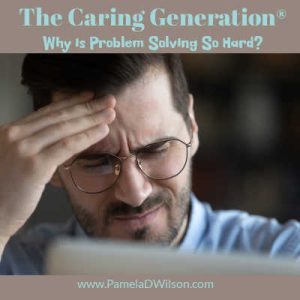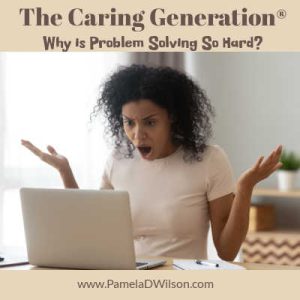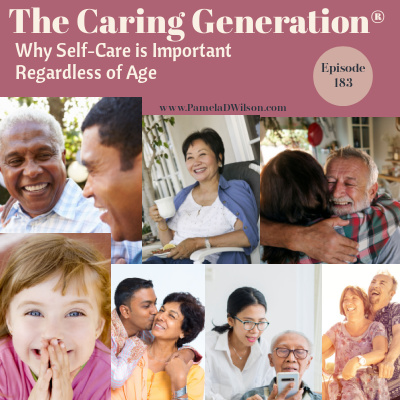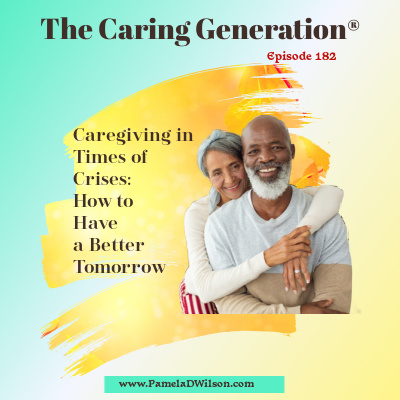Caregiving: Why is Problem Solving So Hard?

The Caring Generation® – Episode 162 March 8, 2023 Caregivers ask why is problem-solving is hard. When caring for aging parents, problem-solving can be complicated by emotions, exhaustion, health care issues, and more. Pamela D Wilson shares how to identify signs that can lead to issues and the steps caregivers can take to avoid concerns spiraling out of control.
Have a question? Follow and connect with Pamela on her social media channels of Twitter, Linked In, Facebook, Instagram, and YouTube or complete the caregiver survey on her website.
Click on the round yellow play button below to listen to the caregiving podcast. To download the show so you can listen anywhere and share it with family, friends, and groups, click on the button (the fourth black button from the left) below that looks like a down arrow. Then, click the heart to go to Pamela’s Spreaker podcast page to like and follow the show. You can also add the podcast app to your cellphone on Apple, Google, and other favorite podcast sites.
During this program, I’ll share eight reasons why problem-solving is so hard. Including actions caregivers can take so they’re not surprised by unexpected problems. Plus, the effects of problem-solving approaches—realism, optimism, and avoidance.
How to Deal With Huge-Sized Caregiving Problems
Watch More Videos About Caregiving and Aging on Pamela’s YouTube Channel
Let’s begin with the idea that to be an effective problem solver; you must be an effective question-asker. Why is problem-solving so hard? Number one is that we don’t recognize that there is a problem. You can’t solve a problem you don’t know exists until it blows up, and you must do something about it.
Problems Sneak Up
Why does this happen? Problems sneak up on us, and we’re too busy to notice the little things.
This thing we don’t know about or can’t see can relate to change blindness. Change blindness is when we get so used to something that small changes happen right before our eyes, and we don’t notice them.
Then over time, these small changes multiply and become significant. It happens to all of us.
But if you are a caregiver, small changes in the health or the ability of loved ones are a big deal because they require more time and effort. Caregiving can become overwhelming when a few hours turns into a full-time job.
Let’s look at a couple of examples. One is memory loss. You see your aging parents every day. While you might realize they’re a little forgetful, you chalk it up to mom and dad getting old.
When Siblings Recognize Problems
So your sister, who lives 1,000 miles away, comes home for a visit and stays with your parents for a week. She is in shock at how forgetful dad has become.
She tells you dad has five boxes of the same cereal in the cabinet, ten packages of toilet paper in the basement, and late notices for past due bills showing up in the mail. And she refuses to go anywhere with your father if he insists on driving the car.
There are prescription bottles from months ago with pills inside the bottle. Dad isn’t taking his medications. Your sister did a little research. One of the medications dad was prescribed is for memory loss. You live in town and visit your parents every few weeks but never go through their cabinets, mail, or prescription bottles. And if you go anywhere, you always drive.
So how could you have missed these warning signs about caring for aging parents? You may not know, but have a potential problem that is about to get really big?
Too Close to Notice Changes
Sometimes being too close to a problem means we don’t see it because we get used to it. But, on the other hand, sometimes we don’t want to see the problem because it can mean more work for us.
Maybe we don’t have time to get involved or are unsure how to solve the problem. So if parents don’t ask for help, their children don’t know there is a problem and don’t offer to help.
So in this circumstance, change blindness is personal. We get used to things, and unless someone else points out something, we don’t notice.
And then there’s that other thing. People don’t like to be told something is wrong. They don’t want to be told what to do. So all of these aspects complicate why problem-solving is so difficult.
Let’s return to things we get used to that can cause problems. For example, that leaky kitchen sink can become a huge plumbing problem. Or you have what you think is an age spot on your face but don’t realize it’s skin cancer until you need surgery for basal cell carcinoma.
These issues are not limited to everyday people like you and me. They even happen to public figures. One example is Kathy Sabine, a meteorologist from 9 News in Denver.
I’ll place a link to her story in the show transcript. She was diagnosed with skin cancer on her face. The article features a photo of her face before and after treatment.
So the first answer to why we do not know any better is that we don’t see things as important enough to ask ourselves—is this something I should investigate further? We may not have time. Can this add to problems?
Yes, not having time can be a problem. I know—that’s not the answer you want to hear, but it is honest.
One Thing Leads to Another

It’s better to view hearing information we don’t like as an opportunity to change something that might become a more significant problem. It’s the idea of a blessing in disguise.
Something unexpected happens that causes us to do something. Then, we look back and realize that that random thing saved us from a potentially disastrous situation avoided by the grace of God or whoever we believe in.
A lack of experience in NOT noticing something different poses another problem. Not knowing the importance of taking action when you see something that could be a potential problem is a problem.
Now you don’t want to look at everything in life as a potential problem because that would drive you crazy, right?
But you might begin paying close attention to interactions with the person you care for and start writing down or recording things you see that seem out of the ordinary or don’t make sense, no matter how small or big. For example, what were your parents previously able to do that they can’t do today? The same goes for you.
There is a quality called discernment – which means grasping and comprehending things that are not obvious. How can you gain this quality or skill? Begin noticing changes in your abilities as the caregiver. In what areas are you helping more?
Solving the Right Problem
The question is, should you be helping more or helping your parents be proactive about why they can’t do something so they can continue to complete that task?
A simple example is a basement laundry room. You are worried about mom or dad walking down the steps to the laundry room because they have poor balance or are physically weak. You worry they might fall and injure themselves.
So your solution is to move the washer and dryer upstairs or do the laundry for them. But is this solving the right problem? What is the issue?
Mom and dad used to be able to do their laundry, and today it isn’t easy. What’s the problem?
Let’s ask a few questions. Why is doing laundry difficult? Physical weakness or poor balance. So is the problem doing the laundry, or is the problem physical weakness or poor balance that makes it difficult for mom or dad to do the laundry?
If mom or dad become physically stronger and their balance improves, can they continue to do their laundry? And if this happens, how many other activities can mom or dad continue to do for themselves that you, as the caregiver, will not have to do?
The Easy Solution May Not Be the Best
This is a perfect example of why some problems are difficult to solve. It’s because we are not solving the right issue.
Moving the laundry upstairs means your parents will be less active and become more physically weak and potentially have worse balance. So by doing this, you contribute to your parent’s inability to manage day-to-day tasks.
The solution for parents continuing to do laundry is to request a physical therapy evaluation from their doctor. And then convince them to exercise daily to get stronger and improve their balance, which means they—not you—do their laundry.
The hidden benefit you may not know about is that becoming stronger makes aging parents less likely to fall performing another activity. So you have solved more than one problem.
Problems that Repeat
This leads us to number two for why is problem solving so hard. The answer is chasing the wrong issue.
Are there problems or issues that repeat in your life? Is there a revolving door of the same issue with a repetitive pattern? A barrier to problem-solving can be the way we look at a problem.
There are repetitive actions that everyone takes that result in outcomes or actions. Things we want and things we don’t want.
It’s the well-known idea of input-output. You put something in you get something out. For every action, there is a reaction.
So one thought to this is to look at your problem-solving approach. What are you putting in if you don’t like the output or the reaction?
Think of this like a recipe. You want to bake a cake. Instead of buying a box of Betty Crocker or Duncan’s cake mix and a can of frosting, you decide to make the cake from scratch.
And, oops, it doesn’t turn out. The cake is sunken in the middle. Maybe you tried to remove the cake from the pan, and half of it stayed in the pan. Or the frosting you made was runny. So you have lumps of frosting around the sides of the cake stand and no frosting on the cake. All that effort and you have a cake you’re embarrassed to show anyone.
Now the cake may look terrible but tastes good. So you eat it anyway and try to think of what to do the next time differently. Or you toss it in the trash and chalk this up to a learning experience.
Huge-Sized Problems
Solving a problem that doesn’t turn out how you expect can be a learning experience. Number three for why is problem-solving so hard. You face a huge-sized problem.
In caregiving, huge-sized problems could be things like realizing that it’s time to move mom or dad to assisted living or another living situation, but they disagree and don’t want to go. Or maybe you moved your parents or in-laws to live in your home. A couple of years have passed. Now you want them out and your life back.
Or perhaps your brother or sister, the primary caregiver, has become overcontrolling. You’re worried they are taking advantage of your parents financially and emotionally.
These huge-sized problems can feel impossible to solve because they will take a lot of time or turn your life upside down. So, what do you do?
I recommend breaking up the issues into stages after you confirm that you know the real problem.
If you can get moving to solve one small piece of the problem, you will likely gain momentum to solve the rest of the problem.
Waiting to be Rescued
 Waiting because you don’t know what to do may make the situation worse than it is today. If you have a huge-sized problem, it didn’t get this big overnight.
Waiting because you don’t know what to do may make the situation worse than it is today. If you have a huge-sized problem, it didn’t get this big overnight.
Have you already delayed action because you felt guilty or for another reason? If so, you’re in good company.
Guilt and feeling overwhelmed prevent many caregivers from solving problems. Number 4 for why is problem-solving so hard is that we may be waiting for someone else to step in or step up.
Or do we want to be rescued? All unlikely to happen unless you make it happen. If you are waiting for uninvolved family members to start helping overnight, that’s probably not going to help.
If you need help from a social services agency or someone in a doctor’s office and you’re not receiving a response – don’t keep waiting — do something about it. Become the squeaky wheel and call every day if you have to.
If the doctor isn’t responsive, consider changing doctors. There can come the point where waiting for others to do something or waiting for a time to be perfect isn’t going to happen.
You must take the bull by the horns and make something happen. Then, decide to move forward in the problem-solving process.
Not Being Personally Affected by a Problem
Why do we wait to take action? Why is problem-solving so hard? Number five is not being personally affected by an issue.
Let’s use doctor appointments as an example. You think mom or dad should see the doctor every three months. Mom or dad resists, but they don’t say why.
You see this as mom or dad being stubborn. But might it be something else? You start asking questions and learn they do not have the money to pay the copay for the appointment.
Then you learn that the copay for a medical specialist is $50 per visit. Because you are healthy and don’t go to the doctor, you had no idea medical care was this costly.
Or you learn that a single prescription costs $100. Being unable to pay for medical care, purchase a drug, or get to doctor’s appointments because of a lack of transportation are major issues for older adults.
Aging Parents May Be Too Proud To Share Problems
Your parents may be too proud or embarrassed money is the issue. If one or any of these are issues, it’s time to investigate options to solve the money and transportation problems.
Rather than assuming parents or anyone is stubborn or does not want to listen to suggestions, get to the bottom of the problem—what is the real issue? Noticing the potential for a problem before it becomes a colossal problem is a solution.
Having insight means not ignoring the problem, waiting for someone else to rescue you, or delaying action, hoping the problem might disappear. Is this likely to happen? Maybe or maybe not. There are times when problems solve themselves in one way or another.
Stuck In Old Beliefs
So what else prevents problem-solving? Number six, denial or not wanting to change beliefs or how we think about a problem can be another problem for problem-solving.
Let’s use the idea of the primary caregiver. Elderly parents or a spouse believe that this primary caregiver is the only person who can help. Or, more often, they don’t want anyone else involved.
Not wanting another person involved could be the idea of having “strangers” come into their life. But, as discussed before, it could also be about a parent not having money.
Primary caregivers who are adult children or spouses don’t have a “perceived cost,” but the problem is that neither does a family caregiver have a “perceived value.” What does this mean?
Trade-offs and Costs
The time caregivers give to care for a parent, or a spouse means that this time cannot be used for other activities. Some caregivers give up their jobs to become a full-time caregivers.
What is the value of that employment? First, you have the salary or the pay that is given up. Then you have contributions to Medicare and social security that you can’t go back and earn.
Caregivers who give up employment lose skills, or skills become rusty. Having rusty skills means re-entering the workforce will be more difficult due to being underskilled or lacking qualifications.
Then you have social and emotional costs. Caregivers give up friends. So while an elderly parent or a spouse may view the caregiver as not having a price, aging parents don’t show appreciation for what a caregiver gives up.
These are topics families do not feel comfortable discussing that eventually become problems. Caregivers don’t realize the significance of these choices when they make them.
You don’t discuss what you are giving up with your aging parents or put a financial cost to your efforts. Why? Because this is the way it’s always been done.
Individual or Family Expectations
That’s number seven for why is problem solving so hard. Expectations.
Because this is what is expected of adult children or a spouse—stop right there. This is an example of not wanting to change personal beliefs about a topic: being a family caregiver.
So concerning a caregiving problem, are you or an aging parent stuck because you refuse to think differently? That is a complex problem to identify, admit, and solve.
Questions to ask around expectations?
- Are my beliefs the problem?
- Am I unwilling to change my thoughts about the issue and consider different perspectives?
- Are there solutions I may not be aware of?
- Does someone know more about this subject than me?
- Am I ignoring the facts of the situation? If so, why?
Most of the reason that we ignore facts or don’t want to think differently is that doing so can take a lot of effort. Why is problem-solving so hard?
Ingrained beliefs about how we think things must be and excuses we make about why we can’t change. So where does all of this point?
Problem-solving is an individual responsibility. As is discernment, which I mentioned in the program’s first half, problem-solving is a learned skill.
It would be great if we could become excellent problem solvers in our early 20s and take this experience and knowledge with us throughout life. Wouldn’t life be much easier?
This leads us to the question of how much do you really want to know. Caregivers have so much on their minds that more details go in and out of their brains.
Different Opinions
There’s only so much attention span available. Only so much energy is available.
How do you know if you are overwhelmed? Think of a day when you forgot to do something routine that you usually do. Or you were inattentive and misplaced an item. This forgetfulness or absent-mindedness is the caregiver’s brain on overload.
All of this leads to number eight, caregivers or anyone who has a problem to solve may not want to engage, speak with, or ask a person who may have opinions that are different or opposite from the way the caregiver thinks.
What’s an example of this? Let’s go controversial and use politics. Democrats and Republicans. Opinions don’t get much more polarized than this.
Unwilling to Think Differently
Polarized means opposite or opposed. Unfortunately, society today is polarized, and the press and media fuel polarization to extreme degrees. People don’t get along because they rely on others to give them the truth or accurate information.
But you will never realize you are at this vulnerable point until you know that it’s possible to be manipulated by receiving false information or only being given half of the information you should know to make decisions. Not having enough information is a leading cause of problem-solving that goes bad.
Why is problem-solving so hard?
1) You don’t recognize a problem or are blind to change happening before your eyes.
2) You haven’t identified the right problem. Remember the laundry example. The problem is physical weakness, not moving the washer and dryer upstairs.
3) Huge size problems that seem too big to solve, so you do nothing.
4) Waiting for someone else to step in or step up.
5) Refusing to change beliefs 6) Not being personally affected by a problem, so you don’t understand why it’s happening.
7)This is the way it’s always been done.
8) Being close-minded to the help and information others can offer – you know it all.
Perceived Cost vs. Perceived Value
Let’s go back to the idea of perceived cost and perceived value. In my opinion, caregivers devalue their efforts.
If the help you provide means that elderly parents continue living in their homes versus moving to assisted living, the value of your time and efforts is at least $60,000 a year. And if you’ve given up your job to be the caregiver, add on your salary, benefits, and other things you can’t get back, like good health.
Your combined value may be well over $80 – 100,000 a year.
While we don’t want to put a price tag on caregiving or helping others, if families were more practical about the life trade-offs and the value of caregivers, we may not end up with huge-sized problems or wait for other people to step in.
How many caregiving issues could we prevent IF we didn’t ignore the facts but focused on personal responsibility?
Planning for the Future
Or at least we were more aware of the consequences of our choices earlier in life. Of course, predicting the future is an interesting thought. But, if we knew everything that would happen in life, would we try to change the events instead of learning from them?
How many movies have been made about people going back in time – remember that old Michael Fox movie from 1985 called Back to the Future?
The title is somewhat misleading because Marty McFly or Michael J Fox gets sent 30 years into the past and meets his mother, who has a crush on him. Check for the link in the show transcript if you were born after 1985 and have no idea what I’m talking about.
But then there’s the idea of planning and prevention. While we can’t plan for everything, we can do our best to anticipate the future based on information and research that is widely available. So we have to search for it.
Realism, Optimism, or Avoidance?
We can avoid blame in problem-solving situations by focusing on new approaches. Being non-judgmental about the cause of the problem—even though this can be hard to do—can increase the focus on what can be done today.
Did you know that approaches to problem-solving can correspond with lifelong habits—realism, optimism, and avoidance? Unfortunately, it is a fact that we cannot get time back.
The last minute we spent is gone forever. Tomorrow will be over in 25 hours. So with this in mind, how do you spend your time?
What inputs are on your to-do list, realizing that problems repeat in life based on inputs and outputs? If you have a problem to solve, what is your general approach?
Realism, optimism, or avoidance, and how will you spend your time? Let’s look at an example of a person with terminal cancer and the options ahead.
Options and Choices
One could be chemotherapy and radiation treatments in the hope of a cure or to extend life. So, all the time spent is back and forth to treatment centers—and most of the time, feeling pretty sick and eventually dying.
Another person in the same situation may not choose treatment but pain and symptom management. This person may choose to spend time with loved ones to make as many memories as possible.
Maybe To travel and arrange aspects of life so that a spouse or adult children do not have a mess of details to deal with after their passing. Neither choice is wrong.
Everyone has a choice about how to deal with bad news—realism, optimism, or avoidance. There are differing opinions about how to deal with bad news.
Bad news can be avoided and not discussed. But in the case of terminal cancer, the outcome- death – will be the same whether families talk about it or not. Others believe that the fact that news is unpleasant is not a reason to avoid it.
Imagine spending time with loved ones and saying goodbye to everyone rather than having death be a surprise. For example, you could write personal letters to your best friends and your children, so they have something to remember you by when you are gone.
Is it Time to Make Different Choices

So while a terminal cancer diagnosis can be viewed as bad news or a problem, it can also be viewed as an opportunity. Not everyone has time to plan for their death.
The truth is we have a lifetime to plan for our death. But unfortunately, many people die unexpectedly from an accident or emergent health problems.
No matter how difficult, each day is a gift or a curse. Why is problem-solving so hard? There are many reasons.
How to get better at problem-solving? First, go back and listen to this program again.
See if any of these ideas match your experiences. Then, decide what you can and will do differently. You can’t get time back, but you can improve the future.
Looking For Help Caring for Elderly Parents? Find the Information, Including Step-by-Step Processes, in Pamela’s Online Program
©2023 Pamela D. Wilson All Rights Reserved





